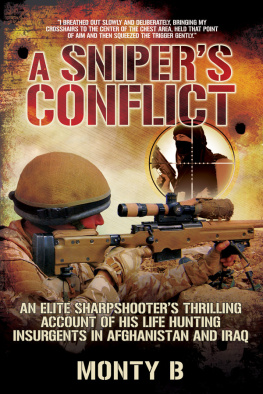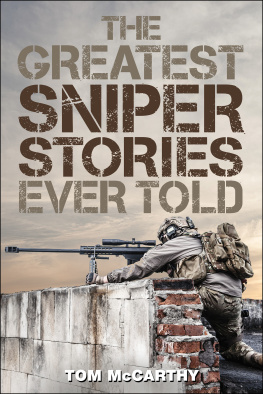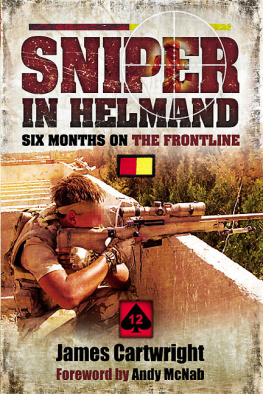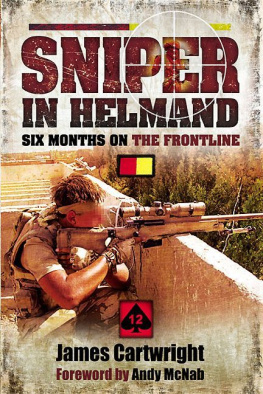Gina Cavallaro - Sniper: American Single-Shot Warriors in Iraq and Afghanistan
Here you can read online Gina Cavallaro - Sniper: American Single-Shot Warriors in Iraq and Afghanistan full text of the book (entire story) in english for free. Download pdf and epub, get meaning, cover and reviews about this ebook. year: 2010, publisher: Lyons Press, genre: Detective and thriller. Description of the work, (preface) as well as reviews are available. Best literature library LitArk.com created for fans of good reading and offers a wide selection of genres:
Romance novel
Science fiction
Adventure
Detective
Science
History
Home and family
Prose
Art
Politics
Computer
Non-fiction
Religion
Business
Children
Humor
Choose a favorite category and find really read worthwhile books. Enjoy immersion in the world of imagination, feel the emotions of the characters or learn something new for yourself, make an fascinating discovery.

- Book:Sniper: American Single-Shot Warriors in Iraq and Afghanistan
- Author:
- Publisher:Lyons Press
- Genre:
- Year:2010
- Rating:3 / 5
- Favourites:Add to favourites
- Your mark:
- 60
- 1
- 2
- 3
- 4
- 5
Sniper: American Single-Shot Warriors in Iraq and Afghanistan: summary, description and annotation
We offer to read an annotation, description, summary or preface (depends on what the author of the book "Sniper: American Single-Shot Warriors in Iraq and Afghanistan" wrote himself). If you haven't found the necessary information about the book — write in the comments, we will try to find it.
Heart-pounding real-life tales from the militarys most experienced snipers, the best of the best snipers in action today. Gunfights, long distance shots, stalking, and more.
Gina Cavallaro: author's other books
Who wrote Sniper: American Single-Shot Warriors in Iraq and Afghanistan? Find out the surname, the name of the author of the book and a list of all author's works by series.
Sniper: American Single-Shot Warriors in Iraq and Afghanistan — read online for free the complete book (whole text) full work
Below is the text of the book, divided by pages. System saving the place of the last page read, allows you to conveniently read the book "Sniper: American Single-Shot Warriors in Iraq and Afghanistan" online for free, without having to search again every time where you left off. Put a bookmark, and you can go to the page where you finished reading at any time.
Font size:
Interval:
Bookmark:
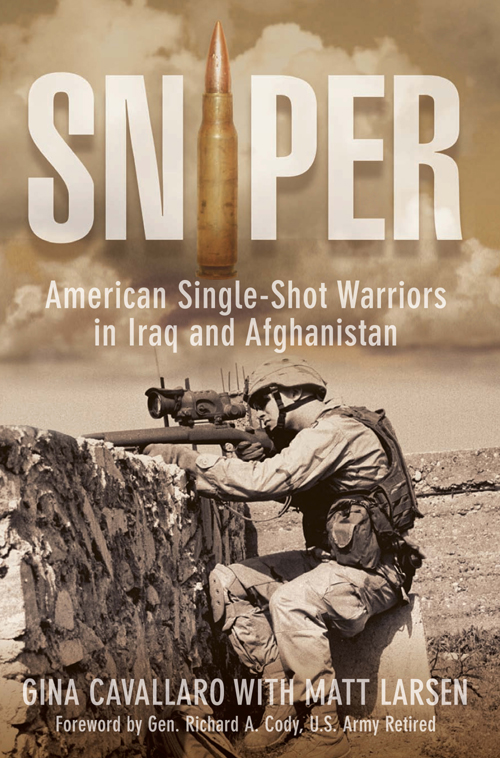
Copyright 2010 by Gina Cavallaro and Matt Larsen
ALL RIGHTS RESERVED. No part of this book may be reproduced or transmitted in any form by any means, electronic or mechanical, including photocopying and recording, or by any information storage and retrieval system, except as may be expressly permitted in writing from the publisher. Requests for permission should be addressed to Globe Pequot Press, Attn: Rights and Permissions Department, P.O. Box 480, Guilford, CT 06437.
Lyons Press is an imprint of Globe Pequot Press.
Text design: Sheryl Kober
Layout artist: Kevin Mak
Project editor: Kristen Mellitt
Library of Congress Cataloging-in-Publication Data is available on file.
ISBN 978-0-7627-8431-8
SNIPER
To my mother Ann, my father Augustine,
and to Specialist Francisco Martinez
Gina
To Steven Langmack, Chris Willoughby,
and Shawn Benjamin
Matt
In 2003, in response to the quick rise in the enemys use of improvised explosive devices in the war on terror and the emergence of more deadly complex attacks, we stood up the Improvised Explosive Device Task Force and redirected the efforts of the Rapid Equipping Force to support counter-IED, countermortar, and countersniper operations.
For this new organization, we recruited and hired experienced former Special Forces noncommissioned officers and teamed them up with active-duty soldiers to form the nucleus of the Improvised Explosive Device Task Force.
Then Col. Joe Votel, former commander of the Seventy-fifth Ranger Regiment, was chosen to lead that effort.
The task forces mission was simple: assess the needs of the troops downrange in Iraq and Afghanistan and find out more about the threats they faced, not only from improvised explosive devices but indirect fires and snipers as well.
It was also tasked with looking beyond the horizon at emerging asymmetrical threats so we could bring the information to the drawing board and developand quickly employcountermeasures, tactics, techniques, and procedures.
The Improvised Explosive Device Task Force members started by interviewing wounded soldiers at Walter Reed Army Medical Center in Washington to get fresh ideas from the warriors recently back from battle on what they thought was needed in terms of equipment and training.
At the same time, we dispatched members of the task force to Iraq and Afghanistan and embedded them with units on the ground to collect the lessons learned directly from the troops in combat.
All of this information was assimilated and pushed through the Army Center for Lessons Learned, then transmitted to the units getting ready to deploy.
As the work of the Improvised Explosive Device Task Force evolved, so did both the complexity of the operational environment and our understanding of it. In response, we built an organization called the Asymmetric Warfare Group and made the members of the Improvised Explosive Device Task Force a part of it.
The Asymmetric Warfare Group, first commanded by Col. Robert Shaw and Command Sgt. Maj. Greg Birch, though focused on the improvised explosive device threat, was also charged with looking past the current problem set to anticipate the next asymmetrical challenge downrange so we could develop training as well as an effective way to advise brigades, battalions, and below on what to look for.
The task force was looking at the pointy end, but just as importantly, it was digging into the network left of Bang! to get ahead of itthe people who planted the bombs, made the bombs, and paid for the bombs.
Sometime in early 2004, we started seeing snipers arrive on the battlefield. There were reports of sniper activity from the commanders downrange, and the enemy snipers who werent successful, the ones we caught, started to yield intelligence on what types of weapons they had and where they had gotten them.
We also wanted to know if that sniper was an untrained guy who just got lucky or a guy with a pretty nice rifle and a pretty nice scope, whether he was positioned professionally when he took a shot, who trained him, and where he was getting his money.
We learned that quite a few of the improvised explosive devices were coming from Hezbollah and a lot of the training of the snipers was coming from Iranian forces.
But to begin countersniper measures, you have to understand how a sniper team operates, how it sets up, and what tactics it uses.
The best people to talk to about that were our own professional snipers, and we had several former Special Forces snipers on our Improvised Explosive Device Task Force and in the Asymmetric Warfare Group.
Between their expertise and knowledge and the operational needs statements we were getting from the field, some of it from task force members themselves, we were able to get some technological assistance for countersniper operations and additions to their fundamental equipment allowances.
Almost immediately, the units started requesting rifles with more capability than the M16 and the M4. One brigade in the 101st Airborne Division (Air Assault) requested the return of the M14, which was the standard issue U.S. rifle until the mid-1960s, because of its longer range and accuracy with a scope.
So, we took the M14s out of depot, issued them to the unit, and then sent several former snipers to Fort Campbell, Kentucky, to train what the brigade commander called his company marksmen to provide over-watch on dangerous roadways and to conduct countersniper operations where possible.
To help these troops on the technical side, the Rapid Equipping Force went out and looked at acoustic and other types of sensor technology that would alert the soldier to the direction of a fired shot. The technology helped them calculate a quick azimuth and distance to where a sniper might be.
Snipers are a very tough problem in urban terrain because of all the different noises and sounds that occur in a city neighborhood, but we were able to allocate money to the Rapid Equipping Force for a device called the Boomerang that can identify the point of origin of gunfire and as these devices continued to develop, we had vehicular-mounted sensing devices and soldier-mounted sensors to help counter the snipers.
The biggest thing that we had going on between 2004 and 2006 was in-country training for soldiers right there in their area of operations by the task force and Asymmetric Warfare Group guys who were downrange with them. The same training was being done for the next-up soldiers back home. All the soldiers were shown how to use the best countermeasures available and how to avoid being vulnerable to snipers.
The former and active-duty snipers they deployed with down-range were the subject matter experts who trained small unit commanders on the employment of their own snipers and how to think like a sniper so they could help their troops stay out of the enemys crosshairs.
Without going too far into everything we taught our officers and enlisted soldiers, we trained them in some simple countersniper tactics like what to be aware of in their surroundings, how to recognize where a sniper might be on the battlefield, and what they could do to counter the invisible threat.
To give our troops an even greater advantage, we looked at alternative sniper weapons, sniper scopes, and night vision systems, and we started training special or designated marksmen who could be sent ahead as a reconnaissance team to counter any threats before an operation. By getting there in advance of a larger element, they could pick out likely danger areas and scan for potential enemy snipers, much like Special Operations forces were already doing.
Font size:
Interval:
Bookmark:
Similar books «Sniper: American Single-Shot Warriors in Iraq and Afghanistan»
Look at similar books to Sniper: American Single-Shot Warriors in Iraq and Afghanistan. We have selected literature similar in name and meaning in the hope of providing readers with more options to find new, interesting, not yet read works.
Discussion, reviews of the book Sniper: American Single-Shot Warriors in Iraq and Afghanistan and just readers' own opinions. Leave your comments, write what you think about the work, its meaning or the main characters. Specify what exactly you liked and what you didn't like, and why you think so.

